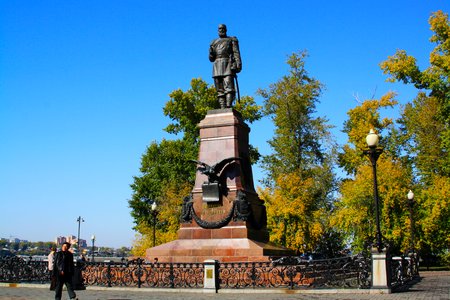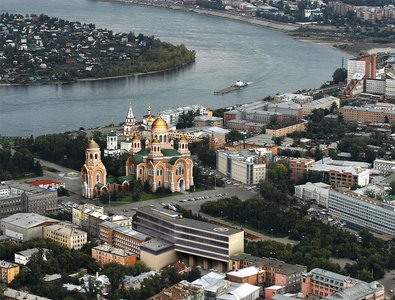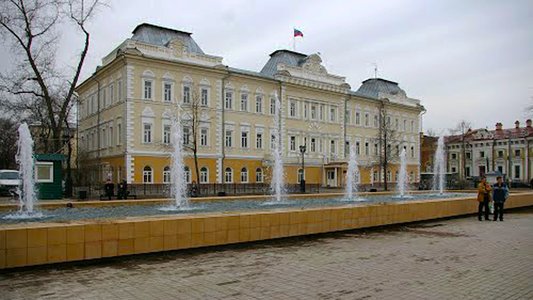White House
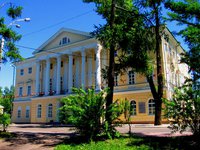
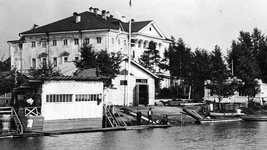
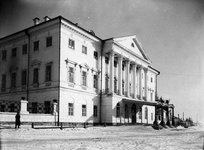
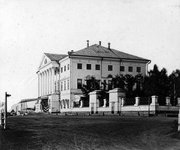
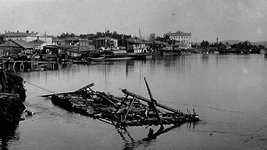
Behind the magnificent ligth of poplars you can see the colonnade of the Sibiryakov Palace or, as the townspeople call it, the White House (Gagarin Boulevard, 24). This mansion was built by the merchant, the first mayor Mikhail Vasilyevich Sibiryakov (he was elected to this position three times: in 1787-1789, 1793-1795, 1799) in 1792-1799 and even then made up a bright decoration of the city, but the merchant himself did not live in it managed to and left it a legacy to the son of Xenophon. “Between all the buildings in Irkutsk,” said traveler and diplomat Aleksey Ivanovich Martos, “the house of the City Head Sibiryakov, built along the Angara embankment, takes first place.”
The house was three-story, built in Greek style and had a very beautiful appearance; but it seemed that the genius of the city did not favor the beauty of the buildings: soon after the construction the Sibiryakov’s house burned down and collapsed: whole walls fell out. For new construction, the ruins of the burnt building were partially demolished, partially fortified; both the first and second houses were almost the same.
The new mansion of merchants Sibiryakov, preserved to this day, was built in 1817-1821. The palace adequately represents the style of Russian classicism on Irkutsk land. The authorship of the mansion is attributed to Giacomo Quarenghi - an outstanding representative of Russian classicism, whose construction cannot be confused with the works of Rastrelli, Bazhenov, Rossi, Kazakov or Stasov. Irkutsk artisans worked on the construction of the White House.
But back to the mansion itself. After the death of K.M. Sibiryakova treasury acquires the palace from the heirs to house the residence of the Governor General of Eastern Siberia - the highest representative of the tsarist government in the entire district. Within these walls, the residence was located in 1837-1917. It was during this period that the building was visited by many famous travelers, scientists, writers. Among them are admirals, researchers Gennady Nevelskoy, Pyotr Kropotkin, V. Putyatin, traveler Aleksey Martos, poet Pyotr Schumacher, writer Ivan Goncharov, Buryat scientist-philosopher Dorzhi Banzarov, Decembrists Nikolai Bestuzhev, Sergey Volkonsky, Fedor Vadkovsky, Petrashevists Nikolai Speshnev, Fedor Lyvov and many others.
In 1859-1861, on the rights of a relative of the Governor-General, exiled Mikhail Aleksandrovich Bakunin, a well-known figure in the Russian and international revolutionary movement, found refuge here. From here he makes an escape in order to return again to the revolutionary fightning. On March 27, 1841, after interrogation at the White House, the Decembrist Mikhail Sergeyevich Lunin was taken to a new exile. There were also royal people in the White House: His Grace Prince Konstantin Nikolaevich Romanov (sold Russian America), Alexey Alexandrovich Romanov (January 1872), Prince Nikolai Alexandrovich Romanov (June 23 - 25, 1891, future Emperor Nicholas II).
After the overthrow of the tsarist government in Irkutsk on March 3, 1917, the Central Executive Committee of the Soviets of Siberia, the editorial board of newspaper, the Military Revolutionary Committee, and the headquarters of the Red Guard were stationed here. During the White Guard rebellion from December 21 to December 30, 1917, 153 Red Guards staunchly defended the White House. On July 11, 1918, the city was again recaptured by the White Guards, and since November 1919, Irkutsk temporarily became the capital of the Russian Empire, all the embassies of the Entente countries and the General Staff were moved here. It was then that, by personal decree of Alexander Vasilievich Kolchak, on October 27, 1918, a solemn act was signed in the White House on the creation of the first Irkutsk State University in Eastern Siberia. In honor of the heroes of the October Revolution in 1967, a monument was built according to the project of architects S. Nechvolodov, V. Cheremis and sculptor O. Ryascheytsev.
Today, the White House building houses one of the largest libraries in Russia with a collection of more than 3.5 million items, which is annually replenished with 25 - 30 thousand copies. It opened in 1918 by personal decree of A.V. Kolchak. In 1923, the Kazan lawyer bibliophile V.S. became the first director. Manassein, and in 1934 she received the status of the ISU Scientific Library. Everything that came out in Russia over the past century is most fully represented in the library. The book collections of the merchants Kuznetsov, Sibiryakov, Basnins constitute the primary foundation of the rare collection of our book depositories. There are 35 books by S.P. Trubetskoy, about 140 books of the Decembrist M.S. Lunin and over 3000 books of the bibliophile N.S. Romanov (in honor of him since 1991, the Romanov Readings have been held). Among the rare copies are 316 incunabula (first printed books), the oldest of which date back to 1499 and 1519, manuscripts of the XIV - XVIII centuries (the oldest is the “History of the Mongols” by Plano Karpini, XIV century), Siberian editions published since 1775. The library has the largest collection of pre-revolutionary newspapers published in Siberia and the Far East.
The house was three-story, built in Greek style and had a very beautiful appearance; but it seemed that the genius of the city did not favor the beauty of the buildings: soon after the construction the Sibiryakov’s house burned down and collapsed: whole walls fell out. For new construction, the ruins of the burnt building were partially demolished, partially fortified; both the first and second houses were almost the same.
The new mansion of merchants Sibiryakov, preserved to this day, was built in 1817-1821. The palace adequately represents the style of Russian classicism on Irkutsk land. The authorship of the mansion is attributed to Giacomo Quarenghi - an outstanding representative of Russian classicism, whose construction cannot be confused with the works of Rastrelli, Bazhenov, Rossi, Kazakov or Stasov. Irkutsk artisans worked on the construction of the White House.
But back to the mansion itself. After the death of K.M. Sibiryakova treasury acquires the palace from the heirs to house the residence of the Governor General of Eastern Siberia - the highest representative of the tsarist government in the entire district. Within these walls, the residence was located in 1837-1917. It was during this period that the building was visited by many famous travelers, scientists, writers. Among them are admirals, researchers Gennady Nevelskoy, Pyotr Kropotkin, V. Putyatin, traveler Aleksey Martos, poet Pyotr Schumacher, writer Ivan Goncharov, Buryat scientist-philosopher Dorzhi Banzarov, Decembrists Nikolai Bestuzhev, Sergey Volkonsky, Fedor Vadkovsky, Petrashevists Nikolai Speshnev, Fedor Lyvov and many others.
In 1859-1861, on the rights of a relative of the Governor-General, exiled Mikhail Aleksandrovich Bakunin, a well-known figure in the Russian and international revolutionary movement, found refuge here. From here he makes an escape in order to return again to the revolutionary fightning. On March 27, 1841, after interrogation at the White House, the Decembrist Mikhail Sergeyevich Lunin was taken to a new exile. There were also royal people in the White House: His Grace Prince Konstantin Nikolaevich Romanov (sold Russian America), Alexey Alexandrovich Romanov (January 1872), Prince Nikolai Alexandrovich Romanov (June 23 - 25, 1891, future Emperor Nicholas II).
After the overthrow of the tsarist government in Irkutsk on March 3, 1917, the Central Executive Committee of the Soviets of Siberia, the editorial board of newspaper, the Military Revolutionary Committee, and the headquarters of the Red Guard were stationed here. During the White Guard rebellion from December 21 to December 30, 1917, 153 Red Guards staunchly defended the White House. On July 11, 1918, the city was again recaptured by the White Guards, and since November 1919, Irkutsk temporarily became the capital of the Russian Empire, all the embassies of the Entente countries and the General Staff were moved here. It was then that, by personal decree of Alexander Vasilievich Kolchak, on October 27, 1918, a solemn act was signed in the White House on the creation of the first Irkutsk State University in Eastern Siberia. In honor of the heroes of the October Revolution in 1967, a monument was built according to the project of architects S. Nechvolodov, V. Cheremis and sculptor O. Ryascheytsev.
Today, the White House building houses one of the largest libraries in Russia with a collection of more than 3.5 million items, which is annually replenished with 25 - 30 thousand copies. It opened in 1918 by personal decree of A.V. Kolchak. In 1923, the Kazan lawyer bibliophile V.S. became the first director. Manassein, and in 1934 she received the status of the ISU Scientific Library. Everything that came out in Russia over the past century is most fully represented in the library. The book collections of the merchants Kuznetsov, Sibiryakov, Basnins constitute the primary foundation of the rare collection of our book depositories. There are 35 books by S.P. Trubetskoy, about 140 books of the Decembrist M.S. Lunin and over 3000 books of the bibliophile N.S. Romanov (in honor of him since 1991, the Romanov Readings have been held). Among the rare copies are 316 incunabula (first printed books), the oldest of which date back to 1499 and 1519, manuscripts of the XIV - XVIII centuries (the oldest is the “History of the Mongols” by Plano Karpini, XIV century), Siberian editions published since 1775. The library has the largest collection of pre-revolutionary newspapers published in Siberia and the Far East.
